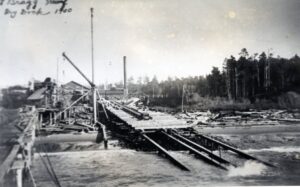Flaming log rafts? How does something already floating in the Pacific Ocean catch fire? Some true events in maritime shipping will always remain a mystery. For the last column in our series on log rafts comes this history tidbit from the August 9, 1941 Mendocino Beacon.

“Radio on Friday morning announced a log raft en route from Puget Sound to San Diego to be burning off the Sonoma County coast about 75 miles north of San Francisco. Vessels were warned to look out for floating logs breaking away from the raft. Fire is about the last thing one would expect to destroy a log raft at sea.”
The article went on to say “Tugs hunting for the raft were unable to locate it due to heavy fog. The raft contained about eight million board feet of lumber. About three years ago a similar raft broke in two off this port and was towed into Mendocino harbor, and a good portion of the logs were run into the river and sawed into lumber at the local mill.”
By the time of this flaming mishap, log rafts had been towed south to San Franciscan or San Diego for 35 years. Very few ever had any problem as has been explained in previous columns. These two raft disasters led to the discontinuance of the practice.
So, what caused this 1941 raft valued at $150,000 to catch on fire? Insurance investigators were sent to determine a cause but were perplexed. One guess was sabotage by another lumber company. The rafts assemblers, Benson Lumber, had inspected it before departure and found no problems. The fire started in the center of the raft and it was suspected chemicals were dropped in the load at some time and were ignited by hot sun or water. The rafts had acetylene tanks and navigational running lights on board and perhaps somehow one caught on fire, but these lights were on the ends of the rafts. The inspectors declared “fire of unknown origin” and that raft was the last one ever to pass the Mendocino Coast.
If it had been later in the war years, after the start of World War II, the Japanese military could have been blamed. The coast saw a lot of paranoia over possible Japanese attack. There were lookouts for Japanese aircraft (Comptche had one) and Japanese submarine incidents were reported from southern California up the entire Pacific Coast. A mine field guarded the entrance to the Columbia River and a Japanese sub tried to trail fishing boats, who knew their way through the minefield, into the river. They were caught.
The one bit of Japanese subterfuge that did work, later in the war, were incendiary balloons, called Fugos. They were launched, rose to 9,000 feet in altitude and blew eastward. With 50 pounds of incendiary explosives attached they could rise to 30,000 feet and ride the jet stream winds for 5,000 miles. They were spotted as far east as Iowa and Michigan and were usually intercepted and shot down before they did any damage.
The only civilian combat causalities of World War II on American soil were four kids and their mom on a family picnic. In May of 1945, near Bly, Oregon, their outing ended horribly when they went exploring while dad unpacked the car. The mom and kids discovered a Fugos balloon in a tree and, when they pulled in the lines, it exploded and killed them. The American public never learned of this incident until after the war, as it was censored. There is a memorial at the location today.
So regular readers of this column now know more about the history of log rafts along the coast than anyone might ever want to know. The Kelley House Museum photo collection has many images of their construction and movement along the coast if readers want to see more. Contact Director-Curator Karen McGrath if you want to see those photos on-line and she’ll tell you how. curator@kelleyhousemuseum.org